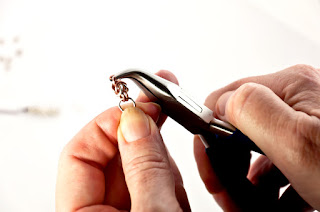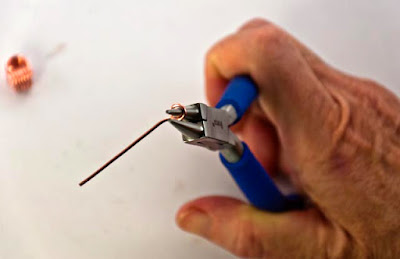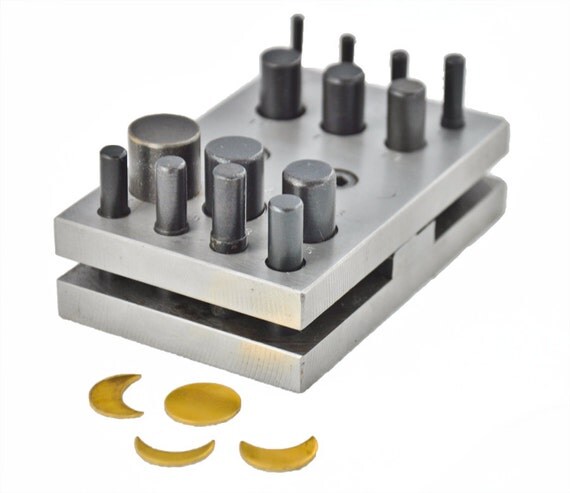Friday, November 27, 2015
Saturday, October 31, 2015
Making a Byzantine Chain
Byzantine Chain
Materials:
- Wire 4'. 6" ~ 132cm 20 gauge 2.5mm ID (Inner Diameter)
24 rings per 2cm (204 rings) - Wire 3' 9" ~ 114cm 18 gauge 4.0mm ID (Inner Diameter)
14 rings per 2cm (120 rings) - Clasp
Tools
Chain nose pliers
Flat nose pliers or Bent nose pliers
Wire tie, or any lace
Jewelers saw, or Flush cutters
Instructions:
 |
| Linked Rings 2-2-2 Chain |
 |
| Flipping the silver rings to the chain sides |
- Open widely the jump rings to be easy to link them
- Place a wire tie or a lace through two closed rings and twist the ends of the closed wire
- Link an open ring through the two closed rings and close the ring. Link a second ring through the same path and close the ring
- Link 2 more open rings to the chain and close them forming a 2-2-2 chain
- Grasp the chain, and the wire tie in your non dominant hand and flip the two top rings (silver rings) to the sides of the chain facing down
- Lift your fingertips away and pin the (silver rings) with your thumb and turn them to the outside of the chain, and push the flipped rings (silver rings) up a little to position against the sides
- Split the two top rings and insert and open ring between the top two rings and through both rings (silver rings) beneath them, then close the ring
- Insert another open ring to the the same path beneath them (silver rings) and close the ring

Splitting the two top rings
 | ||||||
| Inserting a Ring-beneath the silver rings to lock the pattern Locking the pattern |
 | |||||||||||||||||||||||||||||||||||||||||
| Byzantine Chain Maille pattern |
 |
| Repeating pattern to form 2-2-2 chain again |
 |
| Byzantine Chain Maille |
Wednesday, September 30, 2015
How to make Celtic knots links and eye pins loops
Celtic Knot Links
Celtic knot links are interlocking coils of wire held together with simple eye pin links. Using Bail forming pliers helps to make each link the same size and shape.
Materials:
- Round dead soft wire in 18 gauge - 1.02 mm (about 5' ~ 152cm)
Tools:
- Ruler, or Tape measure
- Steel wool
Jewelry pliers:
- Round nose pliers
- Chain nose pliers
- Flat nose pliers
- Bail forming pliers
- Flush cutters
- Clean your wire with a super fine steel wool.

Bail Making Pliers - Place one end of the 18 gauge wire in the jaws of large Bail forming pliers and begin to form a coil on the smaller jaw. As you turn the pliers over your right hand bring the long end of the wire, and continue coiling.
- Wrap the wire around the jaws without gaps between the coils

- When you complete the coiling around the jaws, press down the last 6 mm, using the Flat nose pliers.
- Clean your wire with a super fine steel wool.

Insert Chain nose pliers into the coil, and count six rings. at this point grasp the coil, and tilt the pliers back separating part of the coil.
Flush cut the coil
Flush diagonal side cutter with Tungsten Carbide blades 
Pick two short coils, and insert one of the rings of one coil into the center of the other coil.
Use a Chain nose pliers, or your fingers to turn the coil around like a key ring until the coils are interconnected.
Flush cut 2"~ 5cm of a 18 gauge wire.
Form a small eye pin loop using the Round nose pliers.
Break the neck of the eye pin using the Chain nose pliers.
Insert the eye pin loop into the round nose pliers jaws and center the loop on the straight wire.
Insert the eye pin into the interlocking coils, and create a second eye pin loop.
The Celtic knot link can be used on a bracelet, or necklaces to enhance your jewelry design.
Monday, August 31, 2015
Which pliers should I use for Chain Maille jewelry?
Bail making pliers
 |
| Bail Making Pliers |
Making wire coils of small or big inner diameters for jump rings for Chain Maille jewelry are very easy to form by wrapping wire around the jaws. These pliers are composed of two long cylindrical jaws
with
different diameters on each jaw of the pliers which allow you to form
Jump Rings coils of 25 mm to 38 mm length in multiple sizes.
These bail making pliers has jaws sizes:
1.50 mm & 2.50 mm
- 4.00 mm & 6.00 mm
7.00 mm & 9.00 mm
Opening and closing jump rings
Is one of the most basic and common techniques used in Chain Maille making.- Flat nose pliers are used for thicker wire ( e.g. gauge 16 - 1. 32 mm, or gauge 14 - 1. 63 mm).
- Chain nose pliers are used for thinner wire (e.g. gauge 21 - 0.71 mm, or gauge 22 - 0.64 mm).
**Note: always pull the rings towards your body to open them, never pull them apart from side to side because they will get out of round shape, and to close them in the opposite way you will hear a clicking sound when you reach the ring ends.
 |
| Opening Jump Rings |
Wednesday, July 29, 2015
Unveiling Endless Uses of Flat Nose Pliers in Jewelry Making
Endless Uses of Flat Nose Pliers in Jewelry Making
While Flat Duck Billed nose is the opposite and the exception to tapered jaws, Flat nose pliers, Snipe nose pliers, Needle nose pliers, Bent nose pliers and Chain nose pliers all taper towards a flat end. We can resume saying that the uses of Flat nose pliers in jewelry making is endless.Flat Nose Pliers Jaws Types:
 |
| Parallel Flat Nose Pliers Serrated Jaws |
- Smooth surface in the inner jaws
- Serrated surface in the inner jaws
- Brass Lined inserts in the inner jaws
- Nylon Tips inserts in the inner jaws
Flat Nose Pliers Uses:
 |
| Spiral Post Earrings |
- Holding or Filing wire and sheet metal
- Opening and Closing Jump Rings for Chain Maille making.
- Straightening wire with Parallel Flat nose pliers with Nylon jaws to prevent dents or marring.
- Twisting wire with Parallel Flat nose pliers Serrated jaws with a "V" slot for better grip
- Bending angles or Flattening crimps.
- Flattening wide bands for Rings and for Closing gaps on joints for Soldering operations often Parallel Action Flat nose pliers are used because the pressure is even along the jaws.
- For Gripping or forming spirals shapes on round soft wire and avoid denting or flattening the wire it is better to use Flat nose pliers with Nylon jaws.
- Holding Round Beads or Calottes also known as Clamshell Crimps, Bead Tips or Necklace Ends; these findings are used to get a perfect nice looking finish to your jewelry creations.
- While
keeping your Jewelry work away from scratches, kinks, dents or slipping
is a continuous challenge to any jeweler everyday, they can be
prevented using Flat nose pliers which have treated jaws or matte surface in the inner jaws to avoid slipping or scratches on the wire or metal surfaces or by using pliers with Brass lined jaws or with Nylon jaws for an extra protection.
I would love to hear from you with any other suggestions and uses for all these types of pliers. I welcome your feedback
Thursday, April 23, 2015
How to set Stones with Gem Setting Pliers
With these Gem setting pliers setting stones are easier that you think. The concept is very simple; the
lower jaws of these pliers are stationary while the pliers handle allows the upper
jaws to move up and down, but only up to the distance you already set with the wheel, avoiding fracturing the stone with excessive pressure.
 |
| Gem Setting Pliers |
This particular model features brass lined jaws which means no marring or
scratching your prongs while you are setting the stone in your jewelry.
 |
| Gem Setting Pliers with Brass Lined Jaws |
Thursday, February 19, 2015
How to make holes on Metals for Jewelry Making
To make holes on metals for Cold Connections, Rivets, Links or for Piercing or Sawing Techniques
The techniques which are used to make holes in Jewelry Making are Drilling or by Punch with Cutting Dies.
There are diverse types of tools to use according to the size of the hole that you want to make in your sheet metal piece.
If you need holes with a diameter less than 1.5mm or large sizes you have to use a variety of tools as follows:
A metal ruler or a plastic one. I found one ruler in particular in a fellow blog about scrapping that caught my eye because you can mark precise and even equidistant holes around a disc shape. This is a time saving tool for jewelry making that will help with your designs.
| Piercing Ruler |
 |
| Bench Block and Chasing Hammers |
A Chasing hammer to be able to strike over
the marking punch with the hammer to make a small dent on the sheet metal so the HSS Drill bits don't slip over the metal stock surface.
A Bench block or an anvil as a hard surface to receive the strike of the punch over the metal without deforming the back of the sheet metal surface.
Or an Automatic Marking Metal Punch. These ones come with a spring mechanism which regulates the strike on the punch to make light or hard indentations on the metal surface.
HSS (Stands for High Speed Steel) Twisted Drill Bits and a wax lubricant to smooth and cool the drill bits during the drilling process.
Then we could use a Flex Shaft Rotating Tool or a Jewelers Manual Drill Eggbeater style to attach the drill bit whichever size of choice and start drilling the piece of sheet metal over a wood surface.
 |
| Jewelers Hand Drill Eggbeater Style |
 |
| HSS Drill Bits 1.0mm ~ 2mm Set |
| Parallel Punch Metal Hole Pliers |
If you need standard 1.5mm holes that fit almost all wire sizes, another easy way to do it is using Parallel Metal Hole Punch Pliers.These parallel pliers cut clean holes over the sheet metal up to gauge 20 or 0.80mm thickness and have replaceable cutting pins which last a long time and are quite easy to change.
To make holes of 3mm to 16mm of diameter you can use a Jewelers Disc Cutter Punch Set. This tool is very practical since is equipped with 14 different punch sizes to allow you to cut precise holes and disc metal blanks to use for jewelry making, earrings, bracelets, necklaces, pendants or chains.
 |
Jewelry Hardened Carbon Steel Disc Cutter Metal Set of 14 Pieces 3mm - 16mm. |
Saturday, January 3, 2015
Which Pliers Should I use to make Perfect Jump Rings?
 |
| Jewelry Jump Rings Making Pliers and Wire Cutters |
Which pliers you should use to make consistent Jump Rings and diverse ways how to cut them and which pliers to use for opening and closing jump rings.
Jump Rings:
What are Jump Rings? Before I wrote this article I was curious to check the meaning of Jump Rings and this is what I found:
noun
plural noun: jump rings
a wire ring made by bringing the two ends together without soldering or weldingWikipedia said:
Jump rings are (usually metal) rings used to make chains, jewelry and chain maille.They are made by wrapping wire round a mandrel to make a coil and then cutting the coil with a jeweler saw or wire cutters to make individual rings. The rings can be assembled one by one into chains, earrings, objects such as bowls or ornaments, and chain mail clothing.
The making of items from jump rings is called chain maille ("maille" is French for "mesh").
probably this name was used since the Middle Ages in Europe when the Cavaliers wore a shirt of made of rings forming a mesh "maille"for Sporting ceremonial lancing matches.
My final conclusion is to think that this particular name "Jump Rings" comes from the fact that when you cut a coil of wire at the center with a jeweler saw or a a pair of wire cutters almost most of the time the rings separated from the coil jump away in different directions.
Jump rings can be described by the following qualities :
|
The thickness of the wire the ring is made from. Usually measured according to American Wire Gauge standards or in millimeters, but SWG (Standard Wire Gauge) may be used. |
|
Approximately the same as the outer diameter of the mandrel used to create the rings, but the exact inner diameter will depend on the degree to which the wire springs as it comes off the mandrel. |
|
The gap between the ends of the jump ring created by the cutting process |
|
Saw cut or pinched. The former produces a clean uniform cut whereas the latter is pinched and looks less attractive. |
|
The outer diameter of the ring, this is the same as (twice the gauge + the inner diameter). i.e with a Bail Making Pliers mandrel jaws of 6mm of diameter your final diameter ring if you use a 18 gauge ~ 1.02mm wire is 6mm + 1.02mm x 2 = 8.04mm if you multiple this number by "Pi" ~ 3.1416 you will get the length of wire you will need to cut to make one jump rings in a coil = 25.24mm per ring x 10 rings = 252.4mm ~ 10" |
|
For example, anodized aluminum rings come in many colors. |
| The common materials are Gold (or plated gold), Silver (or plated silver), Aluminum, Brass, Stainless Steel, Copper, Niobium, and Titanium. |
 |
| Jewelry Round Nose Pliers |
There are several Multi size looping pliers models which are used in jewelry making that are very helpful to make jump rings.
Master Coiling Pliers
I personally like to work with these unique pliers to make uniformly well shaped jump rings, clasps, post
earrings backs and other findings easily and efficiently because their flat jaw allows to tighten the wire precisely around the four stepped cylindrical barrels of different
sizes from 1.5mm to 5.5mm diameter without kinking or marring your wire. These pliers are all you need to create consistent and perfect small coils every time. I use Parallel Snipe Chain Nose Locking Pliers and the Parallel Flat Nose Locking Pliers for wider coils to hold them because these pliers have a locking knob which keep wire coils fixed in place and safe to cut them with a Jeweler's Saw.
 |
| Jewelry Master Coiling Pliers |
 |
| Jewelry Multi Size Wire Looping Pliers |
Multi Size Wire Looping Pliers
With these pliers you can make multiple wire coils in six different sizes 2.0mm, 4.0mm, 7.0mm & 3.0mm, 5.0mm, 9.0mm. to make Ear Wires, Jump Rings in multiple sizes, S Hook Clasps, Bails for Pendants Filigree work, Custom figure eight links, S hook clasps, bails for pendants that are a difficult fit. Using these pliers is easy and you can make of any kind of wire shape by wrapping and forming your connections around the jaws.
With these pliers you can make multiple wire coils in six different sizes 2.0mm, 4.0mm, 7.0mm & 3.0mm, 5.0mm, 9.0mm. to make Ear Wires, Jump Rings in multiple sizes, S Hook Clasps, Bails for Pendants Filigree work, Custom figure eight links, S hook clasps, bails for pendants that are a difficult fit. Using these pliers is easy and you can make of any kind of wire shape by wrapping and forming your connections around the jaws.
Bail Making Pliers
With these Bail Making Pliers you can create bails and wire twists by wrapping
wire around the jaws that are composed of two long cylindrical jaws with
different diameter in each jaw of the pliers which allow you to form
Jump Rings in multiple sizes, French Ear Wire, S Hook Clasps, Custom figures, Eight links, Bails for Pendant with larger coils to get more jump rings for the production of chains.
These pliers are made with different diameter jaws sizes of 1.5mm & 2.5mm , 4.0 mm & 6.00mm and 7.0mm & 9.0mm.
 |
| Jewelry Multi Size Wire Looping Pliers and Bail Making Pliers |
Opening and Closing Jump Rings
After the coil of wire has been cut with wire cutters or with a jeweler's saw, the kerf of the rings become wide open and a little out of shape, and we need to manipulate them with a pair of pliers by the extremes of the wire ends which form the rings to reshape them to become circular again.
To open and closing jump rings in Jewelry Making the most used pliers are Flat Nose Pliers, Chain Nose Pliers or Chain maille making pliers and Bent Nose Pliers to manipulate the rings until both wire ends become tight close to form a circular shape.
.jpg) |
| Jewelry Jump Rings Closing Pliers |
I hope that this little guide gives you a more clear scope of which pliers to use to make consistent and perfect Jump Rings every time for your future creations in Jewelry making.
Subscribe to:
Comments (Atom)




